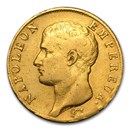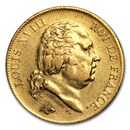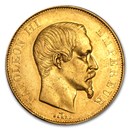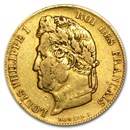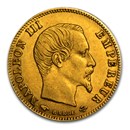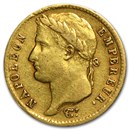Franc French Gold Coins

| Quantity | Check/Wire |
|---|---|
| 1 - 9 | $461.20 |
| 10 - 19 | $460.20 |
| 20 - 49 | $459.20 |
| 50 + | $458.20 |


| Grade | Mintage | Population |
|---|---|---|
| 39,000 | 50 |
French Gold Franc Coins
The French Gold Franc was a gold coin of France that was issued between 1360 and 1914. The coin was initially introduced during the reign of King John II of France, also known as John the Good, as a way to finance his war efforts against the English during the Hundred Years' War.
Over time, the French Gold Franc became one of the most widely recognized and respected gold coins in the world, with a reputation for its consistent high quality and purity. The design of the coin changed over the years, but it typically featured the image of the reigning monarch on the obverse and the French coat of arms on the reverse.
The French Gold Franc underwent several changes throughout its history, including changes in weight and fineness. During the reign of Louis XIII, the coin was revalued, and its weight was reduced, which led to the production of the Louis d'or. The Louis d'or became the standard gold coin of France and was issued from 1640 to 1792.
After the French Revolution, the French Gold Franc was reintroduced in 1803 under the reign of Napoleon Bonaparte. The coin continued to be issued until the outbreak of World War I in 1914, when the French government suspended gold coin production.
Today, French Gold Franc coins are considered to be valuable collector's items due to their historical significance, rarity, and beauty. The value of these coins can vary depending on factors such as the age, condition, and rarity of the specific gold coin.
The Monnaie de Paris
Monnaie de Paris, also known as the Paris Mint, is the oldest French institution in charge of producing coins and medals. It was founded in 864 by Charles the Bald, the King of the West Franks, and has been producing coins continuously ever since.
Located in the heart of Paris, Monnaie de Paris is responsible for producing all French euro coins, as well as other medals, decorations, and commemorative coins. It is also responsible for producing some coins and medals for other countries, such as Monaco, Guinea, and Morocco.
In addition to its production duties, Monnaie de Paris is also a cultural institution that hosts exhibitions and events related to coins, art, and culture. It has a museum on site, called the Musée de la Monnaie, which showcases the history of the Paris Mint, as well as its collection of coins and medals.
Monnaie de Paris has a long history of producing beautiful and intricate coins and medals, with designs that often reflect important historical events, cultural figures, or symbols of French identity. The mint has also been known for its technical innovations, such as the introduction of the first steam-powered coin press in 1833.
The Monnaie de Paris has a long and fascinating history that dates back more than a thousand years. Here are some key events and milestones:
- 864: The Monnaie de Paris was founded by King Charles the Bald as a way to centralize the production of coins in his kingdom.
- 1260: King Louis IX, also known as Saint Louis, introduced a new coin, the franc, which became the standard currency of France and was widely recognized and accepted throughout Europe.
- 1540: King Francis I reorganized the Monnaie de Paris and established the position of the "grand coin master," who was responsible for overseeing the production of coins and ensuring their quality and consistency.
- 1640: King Louis XIII introduced the louis d'or, a new gold coin that became the standard gold currency of France.
- 1791: The French Revolution led to the nationalization of the Monnaie de Paris and the establishment of a new republican currency.
- 1803: Napoleon Bonaparte reorganized the Monnaie de Paris and reinstated the position of grand coin master. He also introduced several new coins, including the napoleon, a gold coin that became the standard French currency.
- 1973: The Monnaie de Paris moved to a new, modern facility in the 13th arrondissement of Paris, where it continues to produce coins and medals to this day.
Throughout its history, the Monnaie de Paris has been known for its technical innovations and artistic excellence. Its coins and medals have reflected the political, cultural, and social trends of their times, and have played an important role in France's history and identity. Today, the Monnaie de Paris continues to produce beautiful and innovative coins and medals that are admired by collectors and appreciated for their artistry and craftsmanship.


